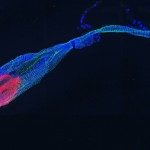Link to Pubmed [PMID] – 18245247
Appl. Environ. Microbiol. 2008 Mar;74(6):1717-25
Photorhabdus luminescens, an entomopathogenic bacterium and nematode symbiont, has homologues of the Hca and Mhp enzymes. In Escherichia coli, these enzymes catalyze the degradation of the aromatic compounds 3-phenylpropionate (3PP) and cinnamic acid (CA) and allow the use of 3PP as sole carbon source. P. luminescens is not able to use 3PP and CA as sole carbon sources but can degrade them. Hca dioxygenase is involved in this degradation pathway. P. luminescens synthesizes CA from phenylalanine via a phenylalanine ammonia-lyase (PAL) and degrades it via the not-yet-characterized biosynthetic pathway of 3,5-dihydroxy-4-isopropylstilbene (ST) antibiotic. CA induces its own synthesis by enhancing the expression of the stlA gene that codes for PAL. P. luminescens bacteria release endogenous CA into the medium at the end of exponential growth and then consume it. Hca dioxygenase is involved in the consumption of endogenous CA but is not required for ST production. This suggests that CA is consumed via at least two separate pathways in P. luminescens: the biosynthesis of ST and a pathway involving the Hca and Mhp enzymes.
